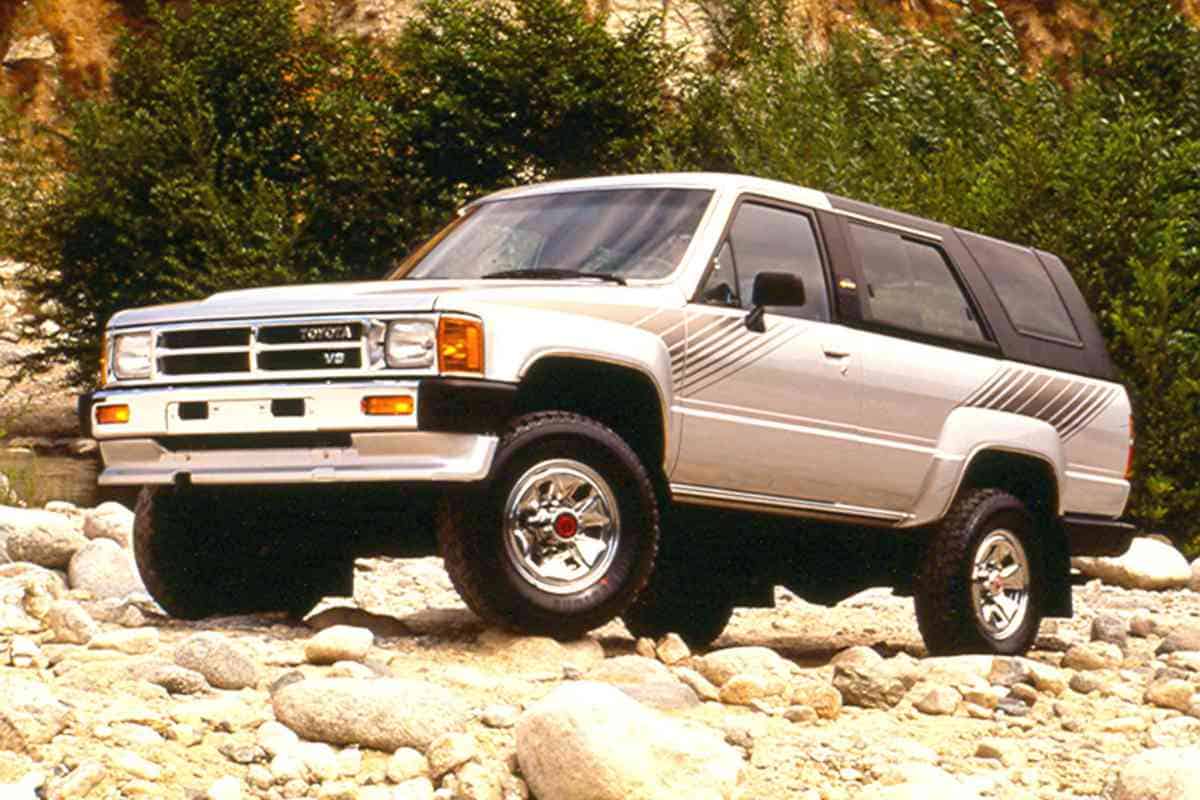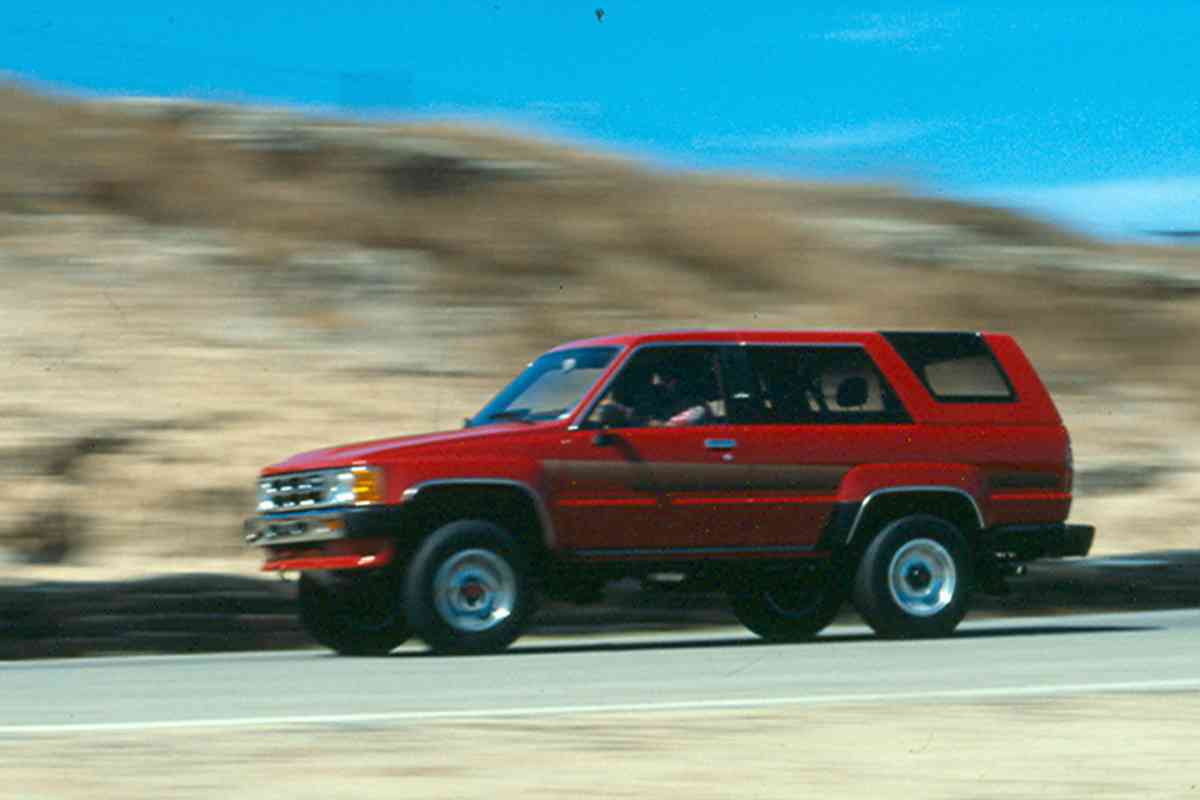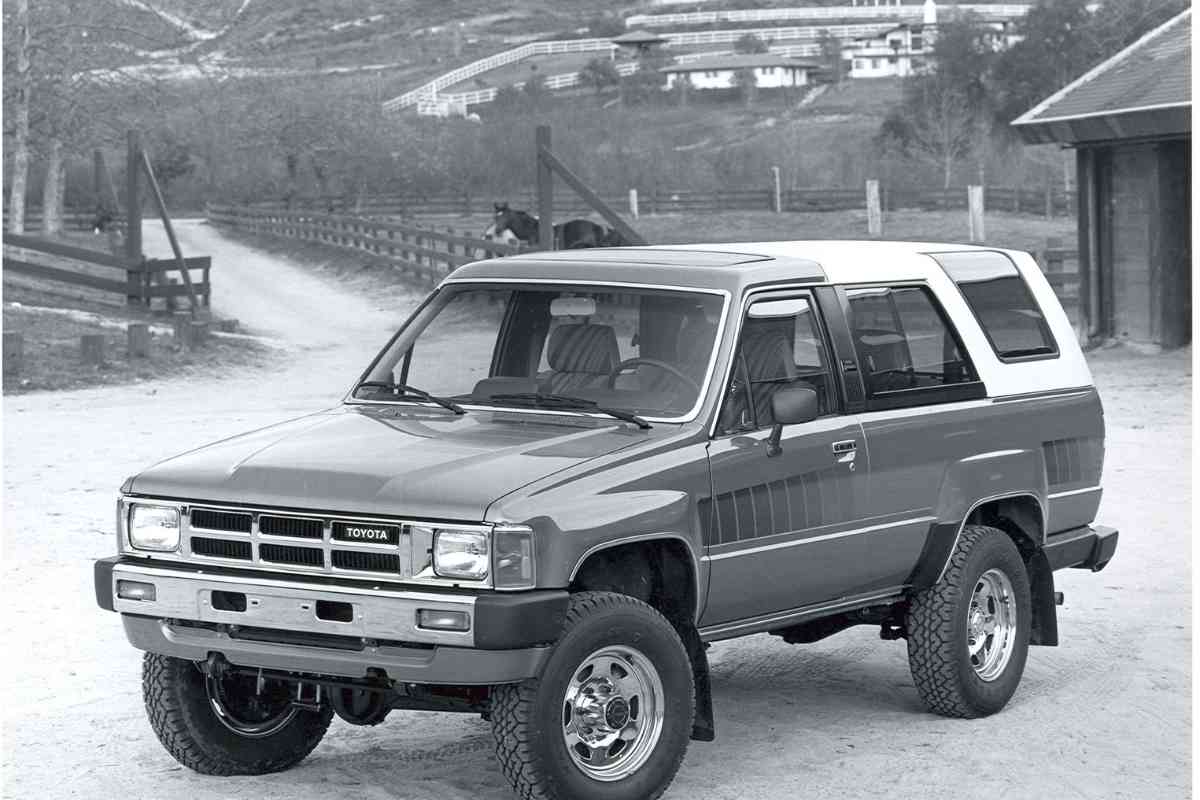1st Generation 4Runner: Pioneering Toyota’s Off-Road Legacy
Have you ever wondered what sparked the SUV revolution? Enter the 1st generation Toyota 4Runner (1984-1989), a true game-changer in the world of sport utility vehicles. This iconic model blended the practicality of a pickup with the comfort of a passenger car, making it an ideal choice for both outdoor enthusiasts and families. But what exactly set this pioneering SUV apart?

Related Post! WHAT GENERATION IS MY 4RUNNER?: IDENTIFYING YOUR MODEL YEAR
When Was The 1st generation of 4runner made?
The first generation Toyota 4Runner, a trailblazer in the SUV market known for its ruggedness and versatility, was produced from 1984 to 1989. During these years, it set new utility and off-road capability standards, influencing future SUV designs and solidifying its iconic status among enthusiasts and adventurers alike.
Imagine yourself behind the wheel of a vehicle that’s as comfortable navigating city streets as it is exploring rugged terrain. That’s the experience the 1st generation 4Runner offered. Whether you’re a fan of off-road adventures or need a reliable family vehicle, the 4Runner was designed with your needs in mind.
The introduction of the 1st generation 4Runner marked a significant milestone in SUV design and functionality. It wasn’t just a vehicle; it was a statement that shaped consumer expectations and the automotive market for years to come.
Historical Context: The 4Runner’s Sturdy Beginnings

In the evolving landscape of sport utility vehicles, the Toyota 4Runner holds a distinct place. Its sturdy design and off-road capability, especially in the first-generation model, set a new standard in the SUV market.
The 4Runner’s journey through generations showcases Toyota’s commitment to meeting consumer needs and embracing technological advancements. Each generation, from the family-friendly second generation to the luxurious third, reflects a deep understanding of what drivers seek in an SUV.
Design and Features
Picture this: It’s the mid-1980s, and the automotive world is about to witness the birth of an icon – the 1st generation Toyota 4Runner. This isn’t just any SUV; it’s a vehicle that redefined ruggedness and versatility, setting itself apart with a distinctive design and robust construction. But what exactly makes this classic 4Runner so special?
Exterior Aesthetics: A Design That Commands Attention
Its classic boxy shape and bold lines are a nod to the rugged utility vehicles of the time. The standout feature? A removable fiberglass shell that effortlessly transforms it from a closed SUV to an open pickup.
And let’s not forget the facelift versions, with their updated grilles and trims, adding even more to its charismatic appeal.
Related Post! TOYOTA 4RUNNER YEARS TO AVOID | 15 BEST & WORST YEARS
Interior Amenities: Comfort Meets Functionality
Step inside the 1st gen 4Runner, and you’ll find a space that’s both practical and comfortable. Depending on the model, you could enjoy features like air conditioning and plush seats, especially in the SR5 trim. The cargo space? It’s generously sized, ready for your daily essentials or adventure gear.
Trim Levels: Catering to Every Preference
The 1st gen 4Runner wasn’t a one-size-fits-all. It came in several trims, each with its unique appeal:
- SR5: This trim took comfort up a notch with upgraded interiors and exteriors.
- Limited: The luxury choice, boasting all the bells and whistles of the era, from enhanced upholstery to advanced technical features.
Regardless of the trim, each 4Runner was a testament to Toyota’s commitment to reliability and durability.

Performance and Capabilities: Built for the Road Less Traveled
Under the hood of the 1st generation 4Runner lies a testament to Toyota’s engineering – a 2.4-liter 22RE engine renowned for its durability. Whether you’re cruising on the highway or navigating rough terrains, this engine, coupled with a choice of a 4-speed automatic or a 5-speed manual transmission, ensures a balanced and powerful driving experience.
Off-Road Prowess: Conquer Any Terrain
For the off-road adventurer, the 1st gen 4Runner is a dream. Its solid front axle and respectable ground clearance mean you can tackle a variety of terrains with ease. The robust four-wheel-drive system adds to this capability, making the 4Runner a revered name among off-roading enthusiasts.
Handling and Control: Confidence in Every Turn
Driving the 1st generation 4Runner, you’ll appreciate its straightforward and reliable handling. Early models featured rear anti-lock brakes, while later ones were equipped with ABS on all wheels, enhancing control during braking. Its hefty weight and balanced design provide a secure feeling, whether you’re on a smooth highway or a challenging backcountry trail.
Legacy and Influence
Imagine a vehicle that not only revolutionizes the automotive world but also becomes a cultural icon. That’s the story of the 1st generation Toyota 4Runner. Known for its durability and versatility, this SUV has left an indelible mark on both the trails and the hearts of enthusiasts.

Cultural Impact: More Than Just a Vehicle
The 1st generation 4Runner isn’t just a mode of transportation; it’s a symbol of adventure and reliability. Its frequent appearances on trails and in popular media have cemented its status as an off-road icon. This SUV has become part of a culture that values rugged functionality and the spirit of outdoor adventuring.
Market and Resale: A Valuable Legacy
When it comes to holding value, the 1st and 3rd generation 4Runners are in a league of their own. A quick glance at auction sites like Bring a Trailer reveals their enduring appeal, with these models often commanding competitive bids. This high demand is a testament to the lasting allure and respect these vehicles command among car enthusiasts and collectors.
Advent of Modifications: Personalizing the Icon
The 4Runner’s popularity has given rise to a thriving aftermarket scene. Here are some common modifications enthusiasts often make:
- Suspension: Lift kits are popular for enhancing ground clearance and off-road prowess.
- Protection: Skid plates and sliders safeguard the underbody on challenging terrains.
- Aesthetics: A range of aftermarket parts are available to boost both the rugged look and functionality of the SUV.
These modifications allow you to tailor your 4Runner for improved off-road capability or to give it a distinctive style, making it a personalized expression of your adventure spirit.
Issues and Reliability: What to Watch For
While the 1st generation 4Runner is renowned for its reliability, there are some common issues to be aware of:
- Head Gasket Issue: The durable 22RE engine may face head gasket failures, especially in older models. Signs include white exhaust smoke or coolant mixing with oil.
- Rust: Pay close attention to the frame and body panels for rust, which can compromise the vehicle’s integrity.
Related Post! THE COSTS OF OWNING A TOYOTA 4RUNNER OVER TIME
Longevity and Maintenance: Keeping the Legend Alive
The 22RE engine is known for its longevity, often reaching high mileage with proper care. Regular oil changes and cooling system maintenance are key. Routine checks of hoses, belts, and addressing any wear signs promptly can significantly enhance the 4Runner’s lifespan.
Typical maintenance actions include:
- Regular oil and filter changes.
- Timing chain inspections and replacements.
- Monitoring and managing fluid levels and leaks.
By staying vigilant and proactive with maintenance, you can ensure your 1st generation 4Runner continues to be a reliable and cherished companion on all your adventures.
Comparative Analysis
The 1st generation 4Runner didn’t rise in isolation; it was part of a competitive landscape that defined the burgeoning SUV class. Let’s look at its key rivals:
- Ford Bronco: Known for its no-nonsense, utilitarian design and strong off-road capabilities.
- Jeep Grand Cherokee: Striking a balance between luxurious comfort and rugged, adventure-ready features.
- Nissan Pathfinder: Gained a reputation for durability and all-terrain performance.
Each of these vehicles, along with the 4Runner, contributed uniquely to the evolving SUV segment.
Related Post! WHICH IS BETTER: 4RUNNER OR TACOMA?

Influences on Later Models: Paving the Way for Future Generations
The legacy of the 1st generation 4Runner is evident in its successors:
- 2nd Gen 4Runner: This iteration evolved to offer more creature comforts while retaining the rugged utility of its predecessor.
- 3rd Gen 4Runner: Further refinement in on-road driving dynamics was achieved without sacrificing off-road capabilities.
Each new generation of the 4Runner carried forward the original’s DNA, blending it with modern enhancements and technological advancements.
4Runner’s Place in Toyota’s Line-up: A Specialized Role
The 1st generation 4Runner holds a unique position in Toyota’s diverse vehicle lineup:
- Toyota Hilux: The rugged chassis foundation of the 4Runner was derived from the Hilux, known for its toughness and reliability.
- Land Cruiser FJ40: The 4Runner can be seen as a sportier, more compact alternative to the larger and more robust Land Cruiser FJ40, sharing a common thread of durability.
- Toyota Tacoma: The success of the 4Runner helped pave the way for the Tacoma, further diversifying Toyota’s offerings in the truck and SUV market.
Frequently Asked Questions
These targeted FAQs are here to guide you through the nuances of the first-generation Toyota 4Runner, a classic and sought-after vehicle for off-road enthusiasts and collectors alike.
What are the common configurations for early Toyota 4Runners?
First-generation 4Runners typically came with a 2.4-liter four-cylinder engine, with options for a turbocharged variant or a 3.0-liter V6 in later models. You commonly find them with either a four-speed automatic or a five-speed manual transmission.
Which lift kits are compatible with early model 4Runners?
Compatible lift kits for early model 4Runners usually range from 2 to 4 inches in lift height. Popular brands include Old Man Emu, Pro Comp, and Skyjacker, which are known for their reliability and fitment with these models.
How does pricing vary for early 4Runners on the used market?
Pricing for early 4Runners varies widely based on condition, mileage, modifications, and geographic location. Prices can range from about $2,000 for a fixer-upper to upwards of $15,000 for well-maintained or restored models.
During which years was the first-generation 4Runner produced?
The first-generation 4Runner was produced from 1984 to 1989. It quickly earned a reputation for being a durable and capable vehicle off-road, contributing to its lasting popularity.
What are some tips for finding a first-generation 4Runner for sale?
To find a first-generation 4Runner for sale, check online marketplaces like AutoTrader or eBay Motors, join 4Runner forums and communities, and look for local listings or car auctions. Inspect the vehicle’s condition, service history, and rust issues thoroughly before making a purchase.
How does the reliability of the first-generation 4Runner compare to newer models?
The first-generation 4Runner is known for its robustness and durability. While it lacks some modern comforts and features, it has a reputation for reliability when properly maintained, often comparable to or better than newer models in terms of mechanical simplicity and ruggedness.
